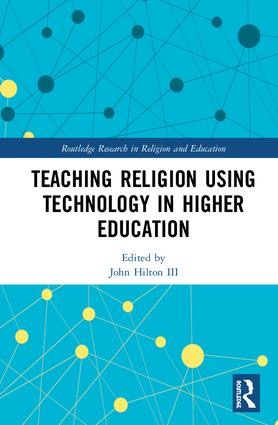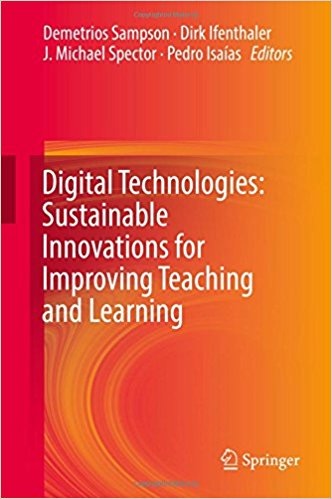digital technologies
Select an item by clicking its checkbox
Date Reviewed: April 15, 2020
Graduate theological education is experiencing a variety of upheavals, including learning how to navigate the digital technologies transforming the teaching-learning process. Navigating these changes necessitates that graduate theological schools and seminaries adopt the mindset of an educational technology company.
Editors Sampson, Ifenthaler, Spector, and Isaías have assembled a collection of international research articles in Digital Technologies: Sustainable Innovations for Improving Teaching and Learning. The articles are organized around four themes: “Transforming the Learning Environment,” “Enriching Student Learning Experiences,” “Measuring and Assessing Teaching and Learning with Educational Data Analysis,” and "Cultivating Student Competencies or the Digital Smart Society.” The rich data found in each of the articles will assist institutions in asking good questions as they seek to discern the instructional tools they will employ to enhance learning.
The essays address the use of digital technologies principally in either a K-12 environment or college-level STEM programs. Despite their focus on different educational contexts, the essays are helpful in explaining the role digital technologies are playing in the educational environment and challenging one to think imaginatively about the implications for graduate theological education.
Wrestling with the articles was enjoyable but imagining how they apply to theological education was enlightening and frustrating at the same time. The articles lack a shared definition of “learning,” this combined with the ends/outcomes of education being implied made assessing the educational value for theological education difficult. In the end, imagining the implications of these articles for theological education was more like making conjectures or discussion starters rather than the bases for working hypotheses.
Digital Technologies will serve as a helpful resource when evaluating digital technologies for inclusion in an institution’s educational strategy. The international character and depth of the articles help one ask good educational questions when evaluating digital learning tools. Asking good technological questions consistent with one’s theological heritage is consistent with being an educational technology company, especially as theological institutions seek to be more nimble in identifying, assessing, evaluating, and implementing sustainable digital technology to enhance learning.

Teaching Religion Using Technology in Higher Education
Date Reviewed: December 14, 2018
This edited volume – the first of its kind – is incredibly valuable for teachers interested in integrating particular technologies into their classrooms. Among the hundreds of scholarly articles and dozens of books about how to incorporate technology into teaching and learning, such as Michelle Miller’s Minds Online (2016, Harvard University Press) and José Antonio Bowen’s Teaching Naked (2012, Jossey-Bass), some articles have focused specifically on the teaching and learning of religion. For example, recent scholarship has shown how 360-degree cameras and virtual reality headsets allow students to become visually immersed in distant religious environments, facilitating an empathetic understanding and ethnographic analysis of religious place, ritual, and behavior (Johnson, “Using virtual reality,” Teaching Theology and Religion 21[2018]: 228-241). Another article looks at how social media technologies might increase student engagement and active learning, for example, when students tweet about experiences of martyrdom from the perspective of the martyr, the crowd, and the persecutors, and compare types of media used to communicate from a position of power and political or social vulnerability (Warren, “Teaching with Technology,” Teaching Theology and Religion 19 [2016]: 309-319).
However, this is the first edited volume on the topic that explicitly addresses those who teach religion in higher education, and as someone who studies digital technologies and uses them for various pedagogical purposes, I thoroughly enjoyed reading it. I appreciated the diversity of technologies discussed, and the candor with which scholars acknowledged that not all technologies enhance or improve student learning. Richard Newton discusses strategies for using mobile devices as learning tools, such as providing backchannels (otherwise known as “live-tweeting”) for students to discuss and address questions while watching in-class films. David Kniep has students create podcasts interviewing religious practitioners, describing how the course challenged or deepened their prior understanding, and connecting scriptural texts to their contemporary world. Renate Hood argues that student response systems can increase student motivation, enhance classroom interaction, and lower students’ apprehension about engaging with religious, ethical, and personal topics. Kristy Slominski shows how clickers can encourage students to take stances on complex religious issues and acknowledge the range of perspectives within the classroom. Kyle Oliver discusses a variety of new media tools to help students visualize sacred sites, including virtual reality technologies such as Google Expeditions, Sites in 3D, and Google Earth, and online videos and picture repositories such as Sacred Destinations and Folkways.
Scholars also address how to leverage social media practices in and out of the classroom. Rob O’Lynn emphasizes the relational quality of social media. Brooke Lester identifies both positive and negative outcomes of social media use: while it can help students form connections and communities, it limits anonymity and sometimes subjects users to online abuse. Anthony Sweat shows how blended learning can help students achieve lower-order outcomes outside of class so that they can focus on higher-order outcomes of analyzing, evaluating, and creating in the classroom. Christopher Heard and Steven Rouse demonstrate that integrating interactive fiction stories did not increase motivation among students, suggesting that not all technology adaptation will improve learning outcomes. Finally, contributors explore ways that technology can expand the classroom, for example, through virtual guest lectures with experts in the field or through massive online open seminars.
